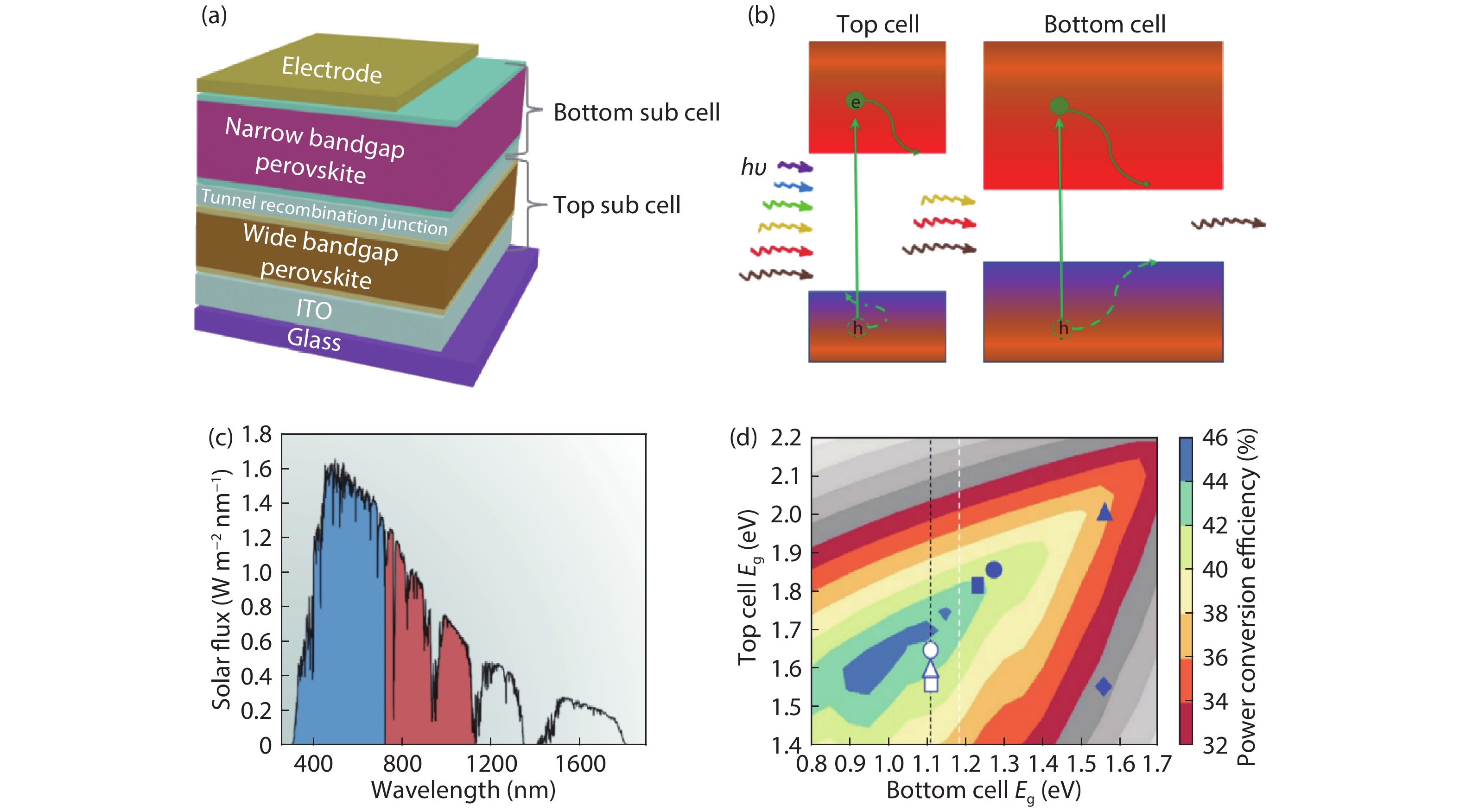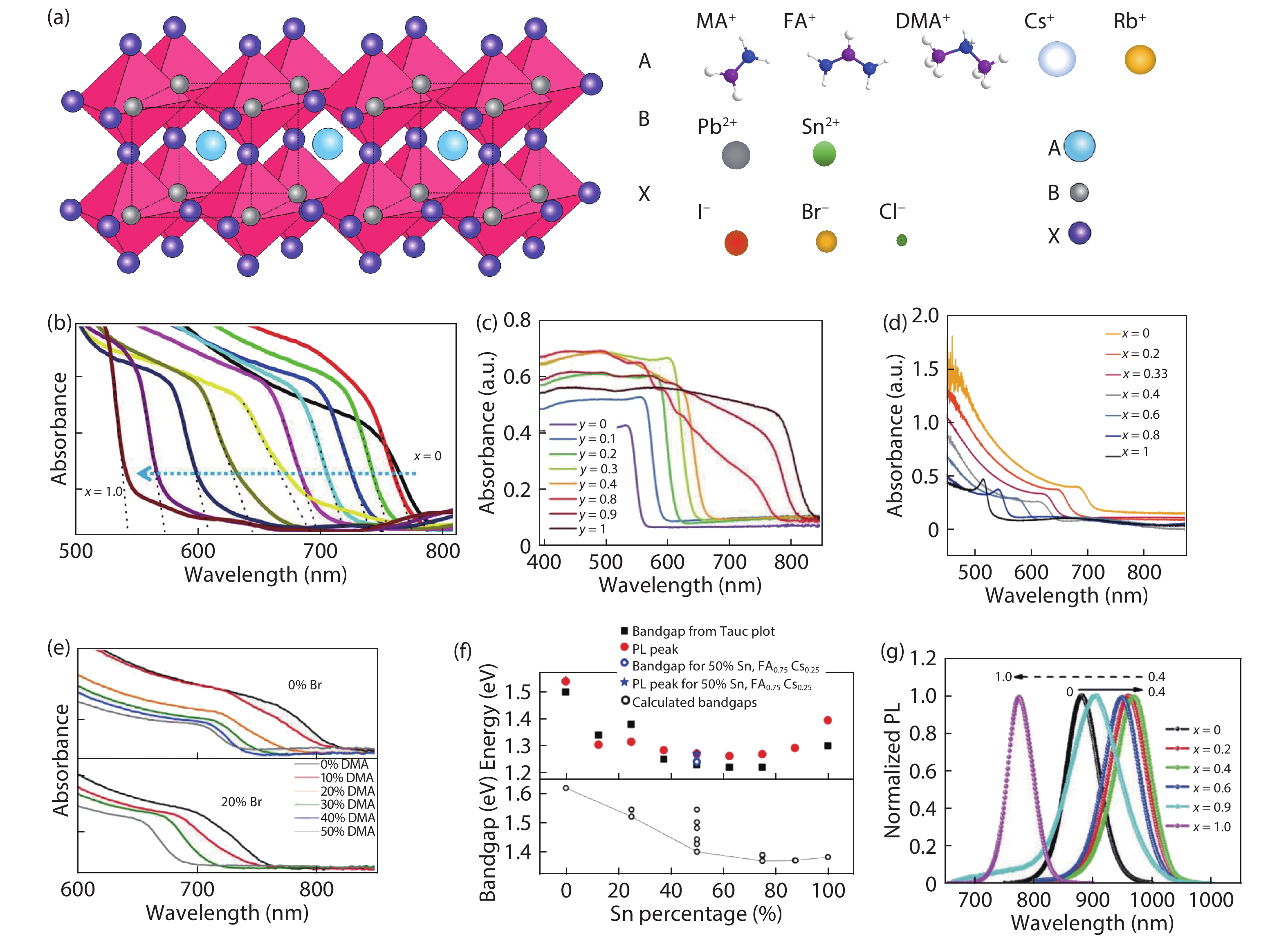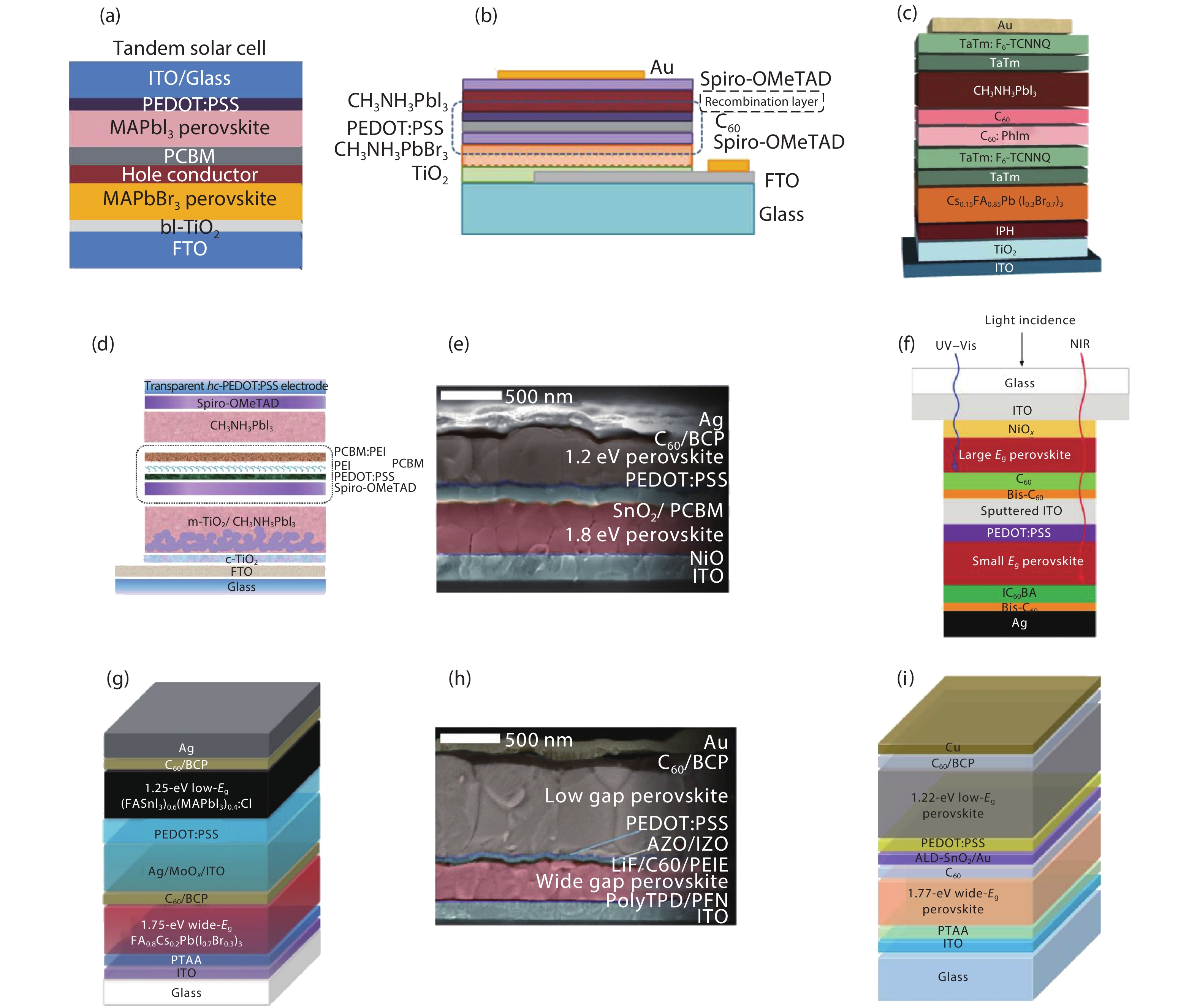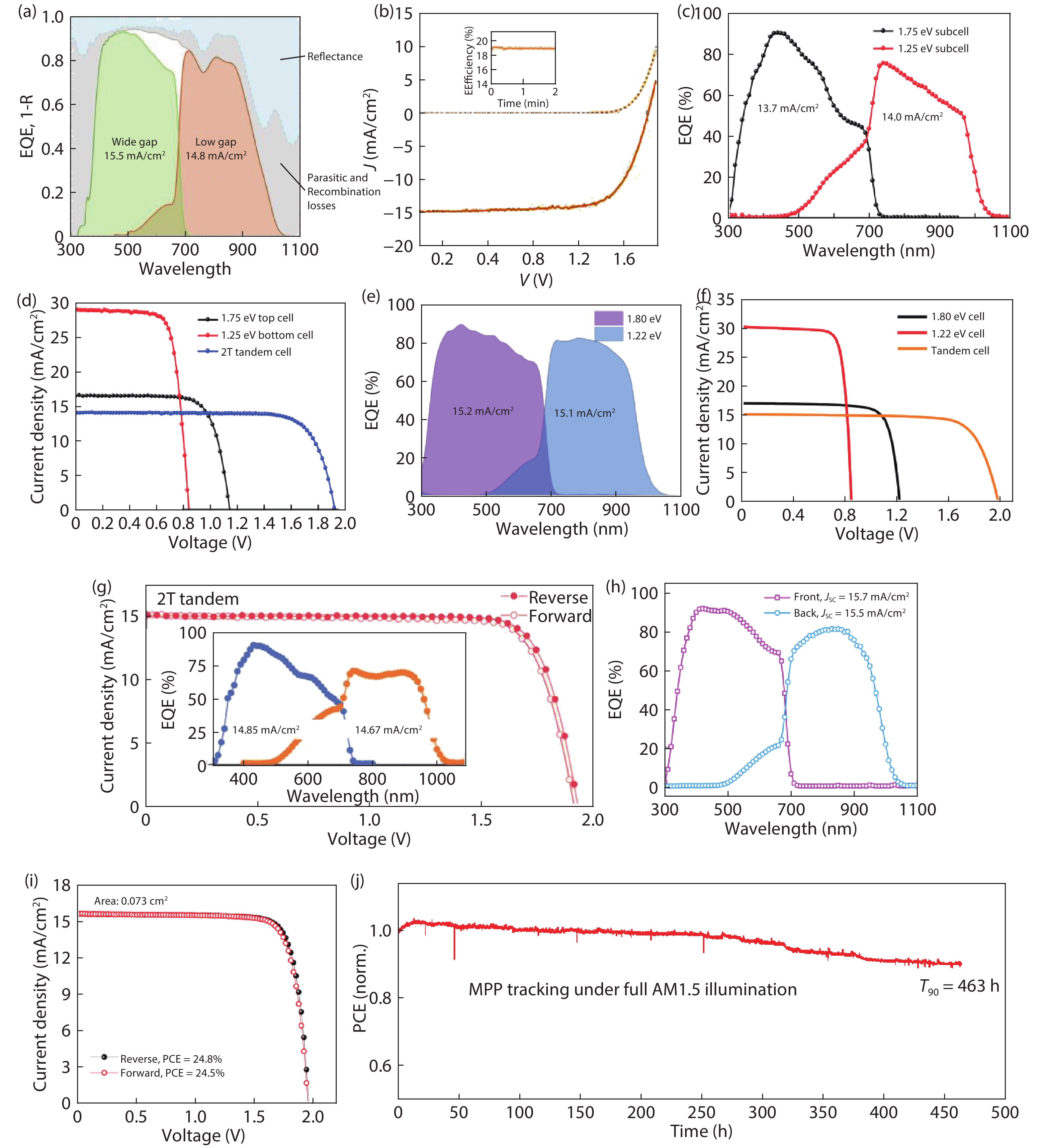| Citation: |
Yurui Wang, Mei Zhang, Ke Xiao, Renxing Lin, Xin Luo, Qiaolei Han, Hairen Tan. Recent progress in developing efficient monolithic all-perovskite tandem solar cells[J]. Journal of Semiconductors, 2020, 41(5): 051201. doi: 10.1088/1674-4926/41/5/051201
****
Y R Wang, M Zhang, K Xiao, R X Lin, X Luo, Q L Han, H R Tan, Recent progress in developing efficient monolithic all-perovskite tandem solar cells[J]. J. Semicond., 2020, 41(5): 051201. doi: 10.1088/1674-4926/41/5/051201.
|
Recent progress in developing efficient monolithic all-perovskite tandem solar cells
DOI: 10.1088/1674-4926/41/5/051201
More Information
-
Abstract
Organic–inorganic halide perovskites have received widespread attention thanks to their strong light absorption, long carrier diffusion lengths, tunable bandgaps, and low temperature processing. Single-junction perovskite solar cells (PSCs) have achieved a boost of the power conversion efficiency (PCE) from 3.8% to 25.2% in just a decade. With the continuous growth of PCE in single-junction PSCs, exploiting of monolithic all-perovskite tandem solar cells is now an important strategy to go beyond the efficiency available in single-junction PSCs. In this review, we first introduce the structure and operation mechanism of monolithic all-perovskite tandem solar cell. We then summarize recent progress in monolithic all-perovskite tandem solar cells from the perspectives of different structural units in the device: tunnel recombination junction, wide-bandgap top subcell, and narrow-bandgap bottom subcell. Finally, we provide our insights into the challenges and scientific issues remaining in this rapidly developing research field. -
References
[1] Jung E H, Jeon N J, Park E Y, et al. Efficient, stable and scalable perovskite solar cells using poly (3-hexylthiophene). Nature, 2019, 567(7749), 511 doi: 10.1038/s41586-019-1036-3[2] Luo D, Yang W, Wang Z, et al. Enhanced photovoltage for inverted planar heterojunction perovskite solar cells. Science, 2018, 360(6396), 1442 doi: 10.1126/science.aap9282[3] Tan H, Jain A, Voznyy O, et al. Efficient and stable solution-processed planar perovskite solar cells via contact passivation. Science, 2017, 355(6326), 722 doi: 10.1126/science.aai9081[4] Tsai H, Nie W, Blancon J C, et al. High-efficiency two-dimensional Ruddlesden –Popper perovskite solar cells. Nature, 2016, 536(7616), 312 doi: 10.1038/nature18306[5] Yang W S, Noh J H, Jeon N J, et al. High-performance photovoltaic perovskite layers fabricated through intramolecular exchange. Science, 2015, 348(6240), 1234 doi: 10.1126/science.aaa9272[6] Zhu P, Gu S, Luo X, et al. Simultaneous contact and grain-boundary passivation in planar perovskite solar cells using SnO2-KCl composite electron transport layer. Adv Energy Mater, 2020, 10(3), 1903083 doi: 10.1002/aenm.201903083[7] Zhao Y, Tan H, Yuan H, et al. Perovskite seeding growth of formamidinium-lead-iodide-based perovskites for efficient and stable solar cells. Nat Commun, 2018, 9(1), 1607 doi: 10.1038/s41467-018-04029-7[8] Han Q, Wei Y, Lin R, et al. Low-temperature processed inorganic hole transport layer for efficient and stable mixed Pb –Sn low-bandgap perovskite solar cells. Sci Bull, 2019, 64(19), 1399 doi: 10.1016/j.scib.2019.08.002[9] Kojima A, Teshima K, Shirai Y, et al. Organometal halide perovskites as visible-light sensitizers for photovoltaic cells. J Am Chem Soc, 2009, 131(17), 6050 doi: 10.1021/ja809598r[10] National Renewable Energy Laboratory. Best research-cell efficiencies. www.nrel.gov/ncpv/images/efficiency_chart.jpg, 2019[11] Green M A, Dunlop E D, Levi D H, et al. Solar cell efficiency tables (version 54). Prog Photovolt Res Appl, 2019, 27(7), 565 doi: 10.1002/pip.3171[12] Shockley W, Queisser H J. Detailed balance limit of efficiency of p–n junction solar cells. J Appl Phys, 1961, 32(3), 510 doi: 10.1063/1.1736034[13] Geisz J F, Steiner M A, Jain N, et al. Building a six-junction inverted metamorphic concentrator solar cell. IEEE J Photovolt, 2017, 8(2), 626 doi: 10.1109/JPHOTOV.2017.2778567[14] Meillaud F, Shah A, Droz C, et al. Efficiency limits for single-junction and tandem solar cells. Sol Energy Mater Sol Cells, 2006, 90(18/19), 2952 doi: 10.1016/j.solmat.2006.06.002[15] Contreras M A, Mansfield L M, Egaas B, et al. Wide bandgap Cu(In, Ga)Se2 solar cells with improved energy conversion efficiency. Prog Photovolt Res Appl, 2012, 20(7), 843 doi: 10.1002/pip.2244[16] Meng L, Zhang Y, Wan X, et al. Organic and solution-processed tandem solar cells with 17.3% efficiency. Science, 2018, 361(6407), 1094 doi: 10.1126/science.aat2612[17] Che X, Li Y, Qu Y, et al. High fabrication yield organic tandem photovoltaics combining vacuum- and solution-processed subcells with 15% efficiency. Nat Energy, 2018, 3(5), 422 doi: 10.1038/s41560-018-0134-z[18] Cheng P, Li G, Zhan X, et al. Next-generation organic photovoltaics based on non-fullerene acceptors. Nat Photonics, 2018, 12(3), 131 doi: 10.1038/s41566-018-0104-9[19] Yuan J, Zhang Y, Zhou L, et al. Single-junction organic solar cell with over 15% efficiency using fused-ring acceptor with electron-deficient core. Joule, 2019, 3(4), 1140 doi: 10.1016/j.joule.2019.01.004[20] Anaya M, Lozano G, Calvo M E, et al. ABX3 perovskites for tandem solar cells. Joule, 2017, 1(4), 769 doi: 10.1016/j.joule.2017.09.017[21] Beal R E, Slotcavage D J, Leijtens T, et al. Cesium lead halide perovskites with improved stability for tandem solar cells. J Phys Chem Lett, 2016, 7(5), 746 doi: 10.1021/acs.jpclett.6b00002[22] Yu Y, Wang C, Grice C R, et al. Synergistic effects of lead thiocyanate additive and solvent annealing on the performance of wide-bandgap perovskite solar cells. ACS Energy Lett, 2017, 2(5), 1177 doi: 10.1021/acsenergylett.7b00278[23] Leijtens T, Bush K A, Prasanna R, et al. Opportunities and challenges for tandem solar cells using metal halide perovskite semiconductors. Nat Energy, 2018, 3(10), 828 doi: 10.1038/s41560-018-0190-4[24] Eperon G E, Stranks S D, Menelaou C, et al. Formamidinium lead trihalide: a broadly tunable perovskite for efficient planar heterojunction solar cells. Energy Environ Sci, 2014, 7(3), 982 doi: 10.1039/c3ee43822h[25] Xu G, Bi P, Wang S, et al. Integrating ultrathin bulk-heterojunction organic semiconductor intermediary for high-performance low-bandgap perovskite solar cells with low energy loss. Adv Funct Mater, 2018, 28(42), 1804427 doi: 10.1002/adfm.201804427[26] Wei M, Xiao K, Walters G, et al. Combining efficiency and stability in mixed tin–lead perovskite solar cells by capping grains with an ultrathin 2D layer. Adv Mater, 2020, 1907058 doi: 10.1002/adma.201907058[27] Li C, Song Z, Zhao D, et al. Reducing saturation-current density to realize high-efficiency low-bandgap mixed tin–lead halide perovskite solar cells. Adv Energy Mater, 2019, 9(3), 1803135 doi: 10.1002/aenm.201803135[28] Liu X, Yang Z, Chueh C C, et al. Improved efficiency and stability of Pb–Sn binary perovskite solar cells by Cs substitution. J Mater Chem A, 2016, 4(46), 17939 doi: 10.1039/C6TA07712A[29] Yang Z, Rajagopal A, Chueh C C, et al. Stable low-bandgap Pb–Sn binary perovskites for tandem solar cells. Adv Mater, 2016, 28(40), 8990 doi: 10.1002/adma.201602696[30] Zhao B, Abdi-Jalebi M, Tabachnyk M, et al. High open-circuit voltages in tin-rich low-bandgap perovskite-based planar heterojunction photovoltaics. Adv Mater, 2017, 29(2), 1604744 doi: 10.1002/adma.201604744[31] Zhu H L, Choy W C H. Crystallization, properties, and challenges of low-bandgap Sn–Pb binary perovskites. Sol RRL, 2018, 2(10), 1800146 doi: 10.1002/solr.201800146[32] Bush K A, Palmstrom A F, Zhengshan J Y, et al. 23.6%-efficient monolithic perovskite/silicon tandem solar cells with improved stability. Nat Energy, 2017, 2(4), 17009 doi: 10.1038/nenergy.2017.9[33] Werner J, Barraud L, Walter A, et al. Efficient near-infrared-transparent perovskite solar cells enabling direct comparison of 4-terminal and monolithic perovskite/silicon tandem cells. ACS Energy Lett, 2016, 1(2), 474 doi: 10.1021/acsenergylett.6b00254[34] Chen B, Zhengshan J Y, Manzoor S, et al. Blade-coated perovskites on textured silicon for 26%-efficient monolithic perovskite/silicon tandem solar cells. Joule, 2020, 4, 850 doi: 10.1016/j.joule.2020.01.008[35] Werner J, Weng C H, Walter A, et al. Efficient monolithic perovskite/silicon tandem solar cell with cell area > 1 cm2. J Phys Chem Lett, 2016, 7(1), 161 doi: 10.1021/acs.jpclett.5b02686[36] Duong T, Wu Y, Shen H, et al. Rubidium multication perovskite with optimized bandgap for perovskite-silicon tandem with over 26% efficiency. Adv Energy Mater, 2017, 7(14), 1700228 doi: 10.1002/aenm.201700228[37] Pisoni S, Fu F, Feurer T, et al. Flexible NIR-transparent perovskite solar cells for all-thin-film tandem photovoltaic devices. J Mater Chem A, 2017, 5(26), 13639 doi: 10.1039/C7TA04225F[38] Shen H, Peng J, Jacobs D, et al. Mechanically-stacked perovskite/CIGS tandem solar cells with efficiency of 23.9% and reduced oxygen sensitivity. Energy Environ Sci, 2018, 11(2), 394 doi: 10.1039/C7EE02627G[39] Todorov T, Gershon T, Gunawan O, et al. Perovskite-kesterite monolithic tandem solar cells with high open-circuit voltage. Appl Phys Lett, 2014, 105(17), 173902 doi: 10.1063/1.4899275[40] Han Q, Hsieh Y T, Meng L, et al. High-performance perovskite/Cu(In, Ga)Se2 monolithic tandem solar cells. Science, 2018, 361(6405), 904 doi: 10.1126/science.aat5055[41] Fu F, Feurer T, Weiss T P, et al. High-efficiency inverted semi-transparent planar perovskite solar cells in substrate configuration. Nat Energy, 2016, 2(1), 1690 doi: 10.1038/nenergy.2016.190[42] Bailie C D, Christoforo M G, Mailoa J P, et al. Semi-transparent perovskite solar cells for tandems with silicon and CIGS. Energy Environ Sci, 2015, 8(3), 956 doi: 10.1039/C4EE03322A[43] Zeng Q, Liu L, Xiao Z, et al. A two-terminal all-inorganic perovskite/organic tandem solar cell. Sci Bull, 2019, 64(13), 885 doi: 10.1016/j.scib.2019.05.015[44] Saha U, Alam M K. Proposition and computational analysis of a kesterite/kesterite tandem solar cell with enhanced efficiency. RSC Adv, 2017, 7(8), 4806 doi: 10.1039/C6RA25704F[45] Li Y, Hu H, Chen B, et al. Solution-processed perovskite-kesterite reflective tandem solar cells. Sol Energy, 2017, 155, 35 doi: 10.1016/j.solener.2017.06.026[46] Lee H, Lee C. Analysis of ion-diffusion-induced interface degradation in inverted perovskite solar cells via restoration of the Ag electrode. Adv Energy Mater, 2018, 8(11), 1702197 doi: 10.1002/aenm.201702197[47] Tanabe K. A Review of ultrahigh efficiency III–V semiconductor compound solar cells: multijunction tandem, lower dimensional, photonic up/down conversion and plasmonic nanometallic structures. Energies, 2009, 2(3), 504 doi: 10.3390/en20300504[48] Ameri T, Li N, Brabec C J. Highly efficient organic tandem solar cells: a follow up review. Energy Environ Sci, 2013, 6(8), 2390 doi: 10.1039/c3ee40388b[49] Yu Z J, Leilaeioun M, Holman Z. Selecting tandem partners for silicon solar cells. Nat Energy, 2016, 1(11), 16137 doi: 10.1038/nenergy.2016.137[50] Celik I, Philips A B, Song Z, et al. Energy payback time (EPBT) and energy return on energy invested (eroi) of perovskite tandem photovoltaic solar cells. IEEE J Photovoltaics, 2017, 8(1), 305 doi: 10.1109/JPHOTOV.2017.2768961[51] Zhengshan J Y, Carpenter J V, Holman Z C. Techno-economic viability of silicon-based tandem photovoltaic modules in the United States. Nat Energy, 2018, 3(9), 747 doi: 10.1038/s41560-018-0201-5[52] Heo J H, Im S H. CH3NH3PbBr3–CH3NH3PbI3 perovskite–perovskite tandem solar cells with exceeding 2.2 V open circuit voltage. Adv Mater, 2016, 28(25), 5121 doi: 10.1002/adma.201501629[53] Eperon G E, Leijtens T, Bush K A, et al. Perovskite-perovskite tandem photovoltaics with optimized band gaps. Science, 2016, 354(6314), 861 doi: 10.1126/science.aaf9717[54] Lin R, Xiao K, Qin Z, et al. Monolithic all-perovskite tandem solar cells with 24.8% efficiency exploiting comproportionation to suppress Sn (II) oxidation in precursor ink. Nat Energy, 2019, 4(10), 864 doi: 10.1038/s41560-019-0466-3[55] Werner J, Niesen B, Ballif C. Perovskite/silicon tandem solar cells: Marriage of convenience or true love story? – An overview Adv Mater Interfaces, 2018, 5(1), 1700731 doi: 10.1002/admi.201700731[56] Eperon G E, Hörantner M T, Snaith H J. Metal halide perovskite tandem and multiple-junction photovoltaics. Nat Rev Chem, 2017, 1(12), 0095 doi: 10.1038/s41570-017-0095[57] Araújo G L, Martí A. Absolute limiting efficiencies for photovoltaic energy conversion. Sol Energy Mater Sol Cells, 1994, 33(2), 213 doi: 10.1016/0927-0248(94)90209-7[58] Hörantner M T, Leijtens T, Ziffer M E, et al. The potential of multijunction perovskite solar cells. ACS Energy Lett, 2017, 2(10), 2506 doi: 10.1021/acsenergylett.7b00647[59] Unger E L, Kegelmann L, Suchan K, et al. Roadmap and roadblocks for the band gap tunability of metal halide perovskites. J Mater Chem A, 2017, 5(23), 11401 doi: 10.1039/C7TA00404D[60] Noh J H, Im S H, Heo J H, et al. Chemical management for colorful, efficient, and stable inorganic–organic hybrid nanostructured solar cells. Nano Lett, 2013, 13(4), 1764 doi: 10.1021/nl400349b[61] Chen W, Zhang J, Xu G, et al. A semitransparent inorganic perovskite film for overcoming ultraviolet light instability of organic solar cells and achieving 14.03% efficiency. Adv Mater, 2018, 30(21), 1800855 doi: 10.1002/adma.201800855[62] Chen W, Chen H, Xu G, et al. Precise control of crystal growth for highly efficient CsPbI2Br perovskite solar cells. Joule, 2019, 3(1), 191 doi: 10.1016/j.joule.2018.10.011[63] Palmstrom A F, Eperon G E, Leijtens T, et al. Enabling flexible all-perovskite tandem solar cells. Joule, 2019, 3(9), 2193 doi: 10.1016/j.joule.2019.05.009[64] Saliba M, Matsui T, Domanski K, et al. Incorporation of rubidium cations into perovskite solar cells improves photovoltaic performance. Science, 2016, 354(6309), 206 doi: 10.1126/science.aah5557[65] Park Y H, Jeong I, Bae S, et al. Inorganic rubidium cation as an enhancer for photovoltaic performance and moisture stability of HC(NH2)2PbI3 perovskite solar cells. Adv Funct Mater, 2017, 27(16), 1605988 doi: 10.1002/adfm.201605988[66] Yadav P, Dar M I, Arora N, et al. The role of rubidium in multiple-cation-based high-efficiency perovskite solar cells. Adv Mater, 2017, 29(40), 1701077 doi: 10.1002/adma.201701077[67] Zhang M, Yun J S, Ma Q, et al. High-efficiency rubidium-incorporated perovskite solar cells by gas quenching. ACS Energy Lett, 2017, 2(2), 438 doi: 10.1021/acsenergylett.6b00697[68] Liao W, Zhao D, Yu Y, et al. Fabrication of efficient low-bandgap perovskite solar cells by combining formamidinium tin iodide with methylammonium lead iodide. J Am Chem Soc, 2016, 138(38), 12360 doi: 10.1021/jacs.6b08337[69] Im J, Stoumpos C C, Jin H, et al. Antagonism between spin-orbit coupling and steric effects causes anomalous band gap evolution in the perovskite photovoltaic materials CH3NH3Sn1– xPb xI3. J Phys Chem Lett, 2015, 6(17), 3503 doi: 10.1021/acs.jpclett.5b01738[70] Prasanna R, Gold-Parker A, Leijtens T, et al. Band gap tuning via lattice contraction and octahedral tilting in perovskite materials for photovoltaics. J Am Chem Soc, 2017, 139(32), 11117 doi: 10.1021/jacs.7b04981[71] Yang Z, Chueh C C, Liang P W, et al. Effects of formamidinium and bromide ion substitution in methylammonium lead triiodide toward high-performance perovskite solar cells. Nano Energy, 2016, 22, 328 doi: 10.1016/j.nanoen.2016.02.033[72] Forgács D, Gil-Escrig L, Pérez-Del-Rey D, et al. Efficient monolithic perovskite/perovskite tandem solar cells. Adv Energy Mater, 2017, 7(8), 1602121 doi: 10.1002/aenm.201602121[73] Rajagopal A, Yang Z, Jo S B, et al. Highly efficient perovskite–perovskite tandem solar cells reaching 80% of the theoretical limit in photovoltage. Adv Mater, 2017, 29(34), 1702140 doi: 10.1002/adma.201702140[74] Jiang F, Liu T, Luo B, et al. A two-terminal perovskite/perovskite tandem solar cell. J Mater Chem A, 2016, 4(4), 1208 doi: 10.1039/C5TA08744A[75] Leijtens T, Prasanna R, Bush K A, et al. Tin–lead halide perovskites with improved thermal and air stability for efficient all-perovskite tandem solar cells. Sustain Energy Fuels, 2018, 2(11), 2450 doi: 10.1039/C8SE00314A[76] Zhao D, Chen C, Wang C, et al. Efficient two-terminal all-perovskite tandem solar cells enabled by high-quality low-bandgap absorber layers. Nat Energy, 2018, 3(12), 1093 doi: 10.1038/s41560-018-0278-x[77] Tong J, Song Z, Kim D H, et al. Carrier lifetimes of > 1 μs in Sn–Pb perovskites enable efficient all-perovskite tandem solar cells. Science, 2019, 364(6439), 475 doi: 10.1126/science.aav7911[78] Prasanna R, Leijtens T, Dunfield S P, et al. Design of low bandgap tin–lead halide perovskite solar cells to achieve thermal, atmospheric and operational stability. Nat Energy, 2019, 4(11), 939 doi: 10.1038/s41560-019-0471-6[79] Sheng R, Hörantner M T, Wang Z, et al. Monolithic wide band gap perovskite/perovskite tandem solar cells with organic recombination layers. J Phys Chem C, 2017, 121(49), 27256 doi: 10.1021/acs.jpcc.7b05517[80] Ávila J, Momblona C, Boix P, et al. High voltage vacuum-deposited CH3NH3Pb3–CH3NH3PbI3 tandem solar cells. Energy Environ Sci, 2018, 11(11), 3292 doi: 10.1039/C8EE01936C[81] Yan Y. All-perovskite tandem solar cell showing unprecedentedly high open-circuit voltage. Joule, 2018, 2(11), 2206 doi: 10.1016/j.joule.2018.10.029[82] Zhao D, Wang C, Song Z, et al. Four-terminal all-perovskite tandem solar cells achieving power conversion efficiencies exceeding 23%. ACS Energy Lett, 2018, 3(2), 305 doi: 10.1021/acsenergylett.7b01287[83] Abdollahi B, Hossain I M, Jakoby M, et al. Vacuum-assisted growth of low-bandgap thin films (FA0.8MA0.2Sn0.5Pb0.5I3) for all-perovskite tandem solar cells. Adv Energy Mater, 2020, 10(5), 1902583 doi: 10.1002/aenm.201902583[84] Braly I L, Stoddard R J, Rajagopal A, et al. Current-induced phase segregation in mixed halide hybrid perovskites and its impact on two-terminal tandem solar cell design. ACS Energy Lett, 2017, 2(8), 1841 doi: 10.1021/acsenergylett.7b00525[85] Stoddard R J, Rajagopal A, Palmer R L, et al. Enhancing defect tolerance and phase stability of high-bandgap perovskites via guanidinium alloying. ACS Energy Lett, 2018, 3(6), 1261 doi: 10.1021/acsenergylett.8b00576[86] Saparov B, Mitzi D B. Organic–inorganic perovskites: structural versatility for functional materials design. Chem Rev, 2016, 116(7), 4558 doi: 10.1021/acs.chemrev.5b00715[87] Zhao D, Yu Y, Wang C, et al. Low-bandgap mixed tin–lead iodide perovskite absorbers with long carrier lifetimes for all-perovskite tandem solar cells. Nat Energy, 2017, 2(4), 17018 doi: 10.1038/nenergy.2017.18[88] Hao F, Stoumpos C C, Guo P, et al. Solvent-mediated crystallization of CH3NH3SnI3 films for heterojunction depleted perovskite solar cells. J Am Chem Soc, 2015, 137(35), 11445 doi: 10.1021/jacs.5b06658[89] Zhou Y, Yang M, Wu W, et al. Room-temperature crystallization of hybrid-perovskite thin films via solvent–solvent extraction for high-performance solar cells. J Mater Chem A, 2015, 3(15), 8178 doi: 10.1039/C5TA00477B[90] Yang Z, Yu Z, Wei H, et al. Enhancing electron diffusion length in narrow-bandgap perovskites for efficient monolithic perovskite tandem solar cells. Nat Commun, 2019, 10(1), 4498 doi: 10.1038/s41467-019-12513-x -
Proportional views





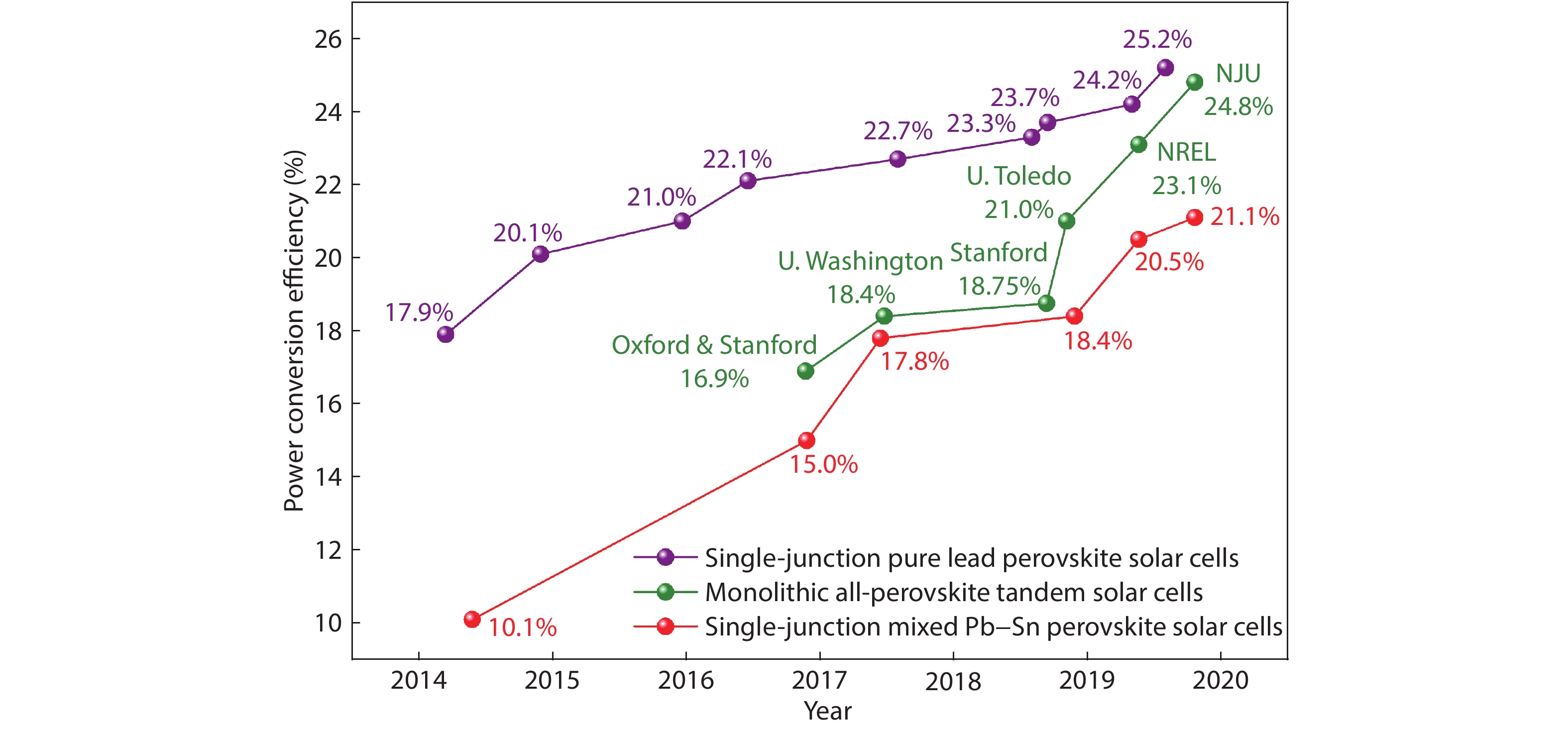
 DownLoad:
DownLoad:
